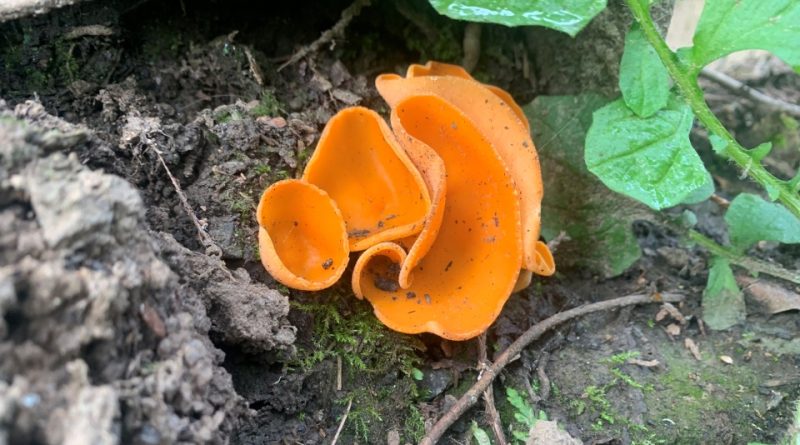Aleuria aurantia
Aleuria aurantia
Aleuria aurantia (Aleuria aurantia (Pers.) Fuckel, 1870) is a mushroom belonging to the Pyronemataceae family.
Systematics –
From a systematic point of view it belongs to:
Eukaryota domain,
Mushroom Kingdom,
Ascomycota division,
Subdivision Pezizomycotina,
Pezizomycetes class,
Pezizales Order,
Family Pyronemataceae,
Genus Aleuria,
Species A. aurantia.
The term is basionym:
– Peziza aurantia Pers..
The terms are synonyms:
– Helvella coccinea Bolton;
– Otidea aurantia (Pers.) Anon.;
– Otidea aurantia (Pers.) Massee;
– Peziza aurantia Pers.;
– Peziza aurantia f. minor Cooke;
– Peziza aurantia subsp. minor Cooke, 1879;
– Peziza aurantia subsp. stipitata W.Phillips, 1887;
– Peziza aurantia var. stipitata W.Phillips;
– Peziza coccinea Huds.;
– Peziza pseudoaurantia P.Crouan & H.Crouan, 1867;
– Scodellina aurantia (Pers.) Gray.
Some varieties are recognized within this species:
– Aleuria aurantia var. aurantia;
– Aleuria aurantia var. cocotina (Cooke) Boud.;
– Aleuria aurantia var. flavida (W.Phillips) Boud.;
– Aleuria aurantia var. splendens Gillet, 1879.
Etymology –
The term Aleuria comes from the Greek ἄλευρον áleuron, flour: due to the externally dandruff cup.
The specific epithet aurantia derives from the botanical Latin, malum aurántium, which means the color of orange.
Geographic Distribution and Habitat –
The Aleuria aurantia is a fungus that bears fruit in summer-autumn, typically in mountain areas, among the gravel of the paths, at the edge of the woods, but sometimes also inside both broad-leaved and coniferous woods, with a preference for siliceous soils.
Its habitat is particular as it grows in large groups, on bare earth, beaten or stony paths, never inside the wood.
Recognition –
Aleuria aurantia is a mushroom that comes in the form of a cup, sessile, up to 10 cm in diameter, often irregularly wavy, generally flattened, even when it does not grow bushy, it tends to tear when it ripens.
The color of the internal surface (hymenium) is an intense orange, more or less intense, and uniform.
The external surface is sub-coloured but may appear paler due to the presence of fine whitish decorations which give it a pruinous or floury appearance, at times it may appear smooth due to particular climatic conditions, without hair.
Under the microscope, elliptical spores can be seen, 16-18(19) × 8-10 µm, including ornamentation, hyaline, with two guttulas evident when immature or still contained in the ascus; when ripe they have crests that can reach 1.5-2 µm, lattice ornamentation with large, partially open meshes, elongated at the poles, uniserial in the ascus.
It has operculate octosporic asci, inamyloid, 180-190(200) × 9-12 µm and cylindrical, septate paraphyses, enlarged at the apex up to 8-9 µm in diameter.
Cultivation –
Aleuria aurantia is an inedible mushroom that is of no interest for its possible cultivation.
Customs and Traditions –
Aleuria aurantia is a fungus that is easy to determine if the morphological analysis is combined with the microscopic one.
If you don’t have a microscope, you have to pay close attention to characteristics of other species such as the greening of the ascoma, the presence of tiny dark hairs on the edge of the apothecium or the presence of a well-differentiated stipe.
Among the mushrooms with which it could be confused are:
Caloscypha fulgens (Pers.: Fr.) Boud. it could arouse some confusion, however it bears fruit in spring in the humid areas of the woods with a preference for those of conifers and already in young specimens it shows the edge of the apothecium shaded bluish green.
The genus Melastiza includes some species similar in color but well distinguished by the presence of a dark down on the external face of the edge of the apothecium (observe with a lens). Inside it is underlined that possible confusions can be made with mushrooms with apothecia that have the same colour, the same habitat and the same dimensions as: Melastiza chateri (W.G. Smith) Boudier, which reaches the same dimensions and more or less the same color , however, its margin is clearly covered by dense brownish hairs.
Another important feature to bear in mind is the absence of a well-developed stem, which therefore easily separates Aleuria aurantia from Sowerbyella rhenana (Fuckel) J. Moravec = Aleuria rhenana Fuckel.
Tremiscus helvelloides (DC.: Fr.) Donk, which bears bushy fruits in mountain woods, is immediately identified and separated due to its gelatinous consistency and generally petaloid habit.
Some species of the genus Scutellinia (Cooke) Lambotte 1887, which however are carpophores of smaller dimensions, and have the margin and the external surface covered by dense hairs up to 2 mm long.
However, both for its flashy orange hues and the tufty growth combined with the size and bright color of the ascomas, they are rather typical, even if not exclusive, characteristics of this beautiful mushroom.
Method of Preparation –
Aleuria aurantia is an inedible mushroom for which it has no food interest.
For this reason it is recommended, a fortiori, not to collect it, above all in order not to compromise the balance of particular habitats and the ecological role of this mushroom.
Guido Bissanti
Sources
– Wikipedia, the free encyclopedia.
– GBIF, the Global Biodiversity Information Facility.
– Useful Tropical Plants Database.
– Cetto B., 2008. Mushrooms from life, Saturnia, Trento.
– Pignatti S., 1982. Flora of Italy, Edagricole, Bologna.
– Conti F., Abbate G., Alessandrini A., Blasi C. (ed.), 2005. An annotated checklist of the Italian vascular flora, Palombi Editore.
Photo source:
– https://inaturalist-open-data.s3.amazonaws.com/photos/200296801/original.jpg
Attention: The pharmaceutical applications and alimurgical uses are indicated for informational purposes only, they do not in any way represent a medical prescription; we therefore decline all responsibility for their use for curative, aesthetic or food purposes.


